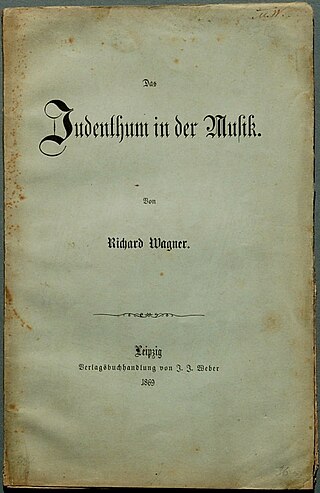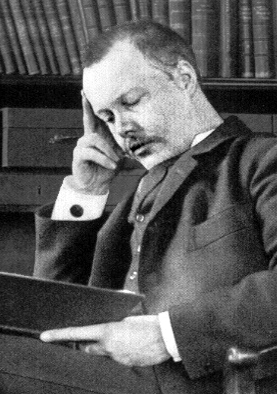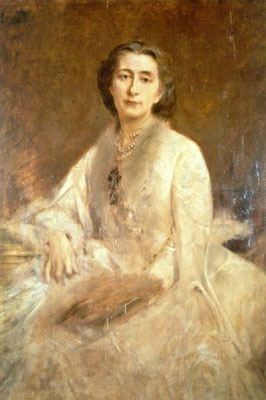History
The term 'Bayreuth Circle' was originally applied to the enthusiasts of Wagner's music who were also associated with or subscribed to the publication Bayreuther Blätter , established in the 1880s by Wagner himself and edited by Hans von Wolzogen. This journal, apart from containing snippets by Wagner himself on social, political and aesthetic matters, was also strongly nationalistic and anti-Semitic. Its circulation was small and it was not politically influential. [2]
After the death of Wagner in 1883, his second wife Cosima, in continuing to propagate what she saw as her husband's views, was supported by a number of active anti-Semites, including Houston Stewart Chamberlain and Ludwig Schemann. Schemann, the founder of the German Gobineau Society, 'did a great deal to bring Gobineau's term 'Aryan' into vogue amongst German racists'. [3] Chamberlain (d. 1927), who wrote an influential anti-Semitic book, The Foundations of the Nineteenth Century, married Eva Wagner, daughter of the composer.
Assertions of political influence
There never was any organisation named the 'Bayreuth Circle' or any group of people who identified themselves by that name, but the term has been used by some historians from about the 1960s onwards as a convenient label for Hitler supporters associated with Bayreuth. Examples of such association are given in the following citations.
- "Only with timely support from the Bayreuth circle, especially Houston S. Chamberlain, Winifred Wagner, and henchmen like Dietrich Eckhart in the Thule Society, could the unimpressive Hitler assume the self- then public image of a Wotan/Siegfried figure, complete with telling nickname: "Wolf." " [4]
- "Thus Hitler himself admitted: `It was Cosima Wagner's merit to have created the link between Bayreuth and National Socialism'. It was the Bayreuth circle which raised Wagner's message to the status of gospel, manoeuvring his ideas into a Germanic-Christian doctrine of salvation." [5]
Strong on assertion, such statements are void of supporting evidence: it should be borne in mind that Eckhardt died in 1923, Chamberlain was dead in 1927, and Cosima Wagner in 1930, i.e. before the first political victory of the Nazi party in the September 1930 elections. Whilst these personages were (or would have been) undoubtedly supporters of Hitler, they played little or no part, and had no influence, in his climb to power. These citations also make the typical, and unsubstantiated, assumption of many modern historians that the German people in general (or even active Nazis in particular) knew, or cared, anything at all about Wagner or his operas. [6]
Evidence for any political active role played by a 'Bayreuth Circle' as a group is therefore highly contentious.
Personalities cited as members
Amongst those often listed as 'members' of a Hitlerian Bayreuth Circle are Cosima Wagner (d. 1930), second wife of the composer, Winifred Wagner, wife of the composer's son Siegfried, and H. S. Chamberlain. None of the Wagners, however, played any personally active role in the Nazi movement, although Hitler was undoubtedly influenced by Chamberlain's Foundations of the Nineteenth Century. Chamberlain himself joined the Nazi Party and contributed to its publications. The Nazi journal Völkischer Beobachter dedicated five columns to praising him on his 70th birthday, describing Foundations as the "gospel of the Nazi movement". [7] Hitler later attended Chamberlain's funeral in January, 1927 along with several highly ranked members of the Nazi party. [8] Other members of the putative 'Circle', such as Winifred Wagner, were sycophants of Hitler, partly from political sympathy, partly in the hopes of obtaining advantages (including financial support) for the Bayreuth Festival. [9] There is however no evidence that the actions of either Chamberlain or Winifred Wagner - or others associated with Bayreuth - led Hitler to power or had any influence over him once he obtained it.

Wilhelm Richard Wagner was a German composer, theatre director, polemicist, and conductor who is chiefly known for his operas. Unlike most opera composers, Wagner wrote both the libretto and the music for each of his stage works. Initially establishing his reputation as a composer of works in the romantic vein of Carl Maria von Weber and Giacomo Meyerbeer, Wagner revolutionised opera through his concept of the Gesamtkunstwerk, by which he sought to synthesise the poetic, visual, musical and dramatic arts, with music subsidiary to drama. He described this vision in a series of essays published between 1849 and 1852. Wagner realised these ideas most fully in the first half of the four-opera cycle Der Ring des Nibelungen.

"Das Judenthum in der Musik" is an essay by Richard Wagner which attacks Jews in general and the composers Giacomo Meyerbeer and Felix Mendelssohn in particular. It was published under a pseudonym in the Neue Zeitschrift für Musik (NZM) of Leipzig in September 1850 and was reissued in a greatly expanded version under Wagner's name in 1869. It is regarded by some as an important landmark in the history of German antisemitism.

Winifred Marjorie Wagner was the English-born wife of Siegfried Wagner, the son of Richard Wagner, and ran the Bayreuth Festival after her husband's death in 1930 until the end of World War II in 1945. She was a friend and supporter of Adolf Hitler, himself a Wagner enthusiast, and she and Hitler maintained a regular correspondence.

The Bayreuth Festival is a music festival held annually in Bayreuth, Germany, at which performances of operas by the 19th-century German composer Richard Wagner are presented. Wagner himself conceived and promoted the idea of a special festival to showcase his own works, in particular his monumental cycle Der Ring des Nibelungen and Parsifal.

Houston Stewart Chamberlain was a British-German philosopher who wrote works about political philosophy and natural science. His writing promoted German ethnonationalism, antisemitism, and scientific racism; and he has been described as a "racialist writer". His best-known book, the two-volume Die Grundlagen des neunzehnten Jahrhunderts, published 1899, became highly influential in the pan-Germanic Völkisch movements of the early 20th century, and later influenced the antisemitism of Nazi racial policy. Indeed, Chamberlain has been referred to as "Hitler's John the Baptist".

Francesca Gaetana Cosima Wagner was the daughter of the Hungarian composer and pianist Franz Liszt and Franco-German romantic author Marie d'Agoult. She became the second wife of the German composer Richard Wagner, and with him founded the Bayreuth Festival as a showcase for his stage works; after his death she devoted the rest of her life to the promotion of his music and philosophy. Commentators have recognised Cosima as the principal inspiration for Wagner's later works, particularly Parsifal.

Siegfried Helferich Richard Wagner was a German composer and conductor, the son of Richard Wagner. He was an opera composer and the artistic director of the Bayreuth Festival from 1908 to 1930.

Essai sur l'inégalité des races humaines is a racist and pseudoscientific work of French writer Joseph Arthur, Comte de Gobineau, which argues that there are intellectual differences between human races, that civilizations decline and fall when the races are mixed and that the white race is superior. It is today considered to be one of the earliest examples of scientific racialism.
Wolfgang Wagner was a German opera director. He is best known as the director (Festspielleiter) of the Bayreuth Festival, a position he initially assumed alongside his brother Wieland in 1951 until the latter's death in 1966. From then on, he assumed total control until he retired in 2008, although many of the productions which he commissioned were severely criticized in their day. He had been plagued by family conflicts and criticism for many years. He was the son of Siegfried Wagner, who was the son of Richard Wagner, and the great-grandson of Franz Liszt.

Karl Eduard Maria Elmendorff was a German opera conductor.

The German composer Richard Wagner was a controversial figure during his lifetime, and has continued to be so after his death. Even today he is associated in the minds of many with Nazism and his operas are often thought to extol the virtues of German nationalism. The writer and Wagner scholar Bryan Magee has written:
I sometimes think there are two Wagners in our culture, almost unrecognizably different from one another: the Wagner possessed by those who know his work, and the Wagner imagined by those who know him only by name and reputation.

Wahnfried was the name given by Richard Wagner to his villa in Bayreuth. The name is a German compound of Wahn and Fried(e).

Marie ("Mimi") Baronessvon Schleinitz was an influential salonnière of the early German Reich in Berlin and one of the most important supporters of Richard Wagner.
Bayreuther Blätter was a monthly journal founded in by Richard Wagner 1878 and edited by Hans von Wolzogen until his death in 1938. It was written primarily for visitors to the Bayreuth Festival.

Isolde Josefa Ludovika Beidler was the first child of the composer Richard Wagner and his wife, who is generally known as Cosima Wagner.
The French aristocrat Arthur de Gobineau developed a set of ideas that were influential during his life and some of them that impacted later social thinkers, such politicians, anthropologists, and sociologists. While still alive, he was a major influence on "Gobinism", also known as Gobineauism, an academic, political and social movement formed in 19th-century Germany. An ethnically pro-Germanic, anti-national and particularly anti-French ideology, the movement influenced German nationalists and intellectuals such as Richard Wagner and Friedrich Nietzsche.
Emil Preetorius was a German illustrator and graphic artist. He is considered one of the most important stage designers of the first half of the 20th century.
Frederic Spotts is an American former diplomat and cultural historian. He was educated in Swarthmore College, Fletcher School of Law and Diplomacy and Oxford University.

The Bayreuth premiere cast of Parsifal lists the contributors to the new productions of Richard Wagner's inaugural stage play Parsifal, including the premiere, which took place on 26 July 1882 at the Bayreuth Festival.












